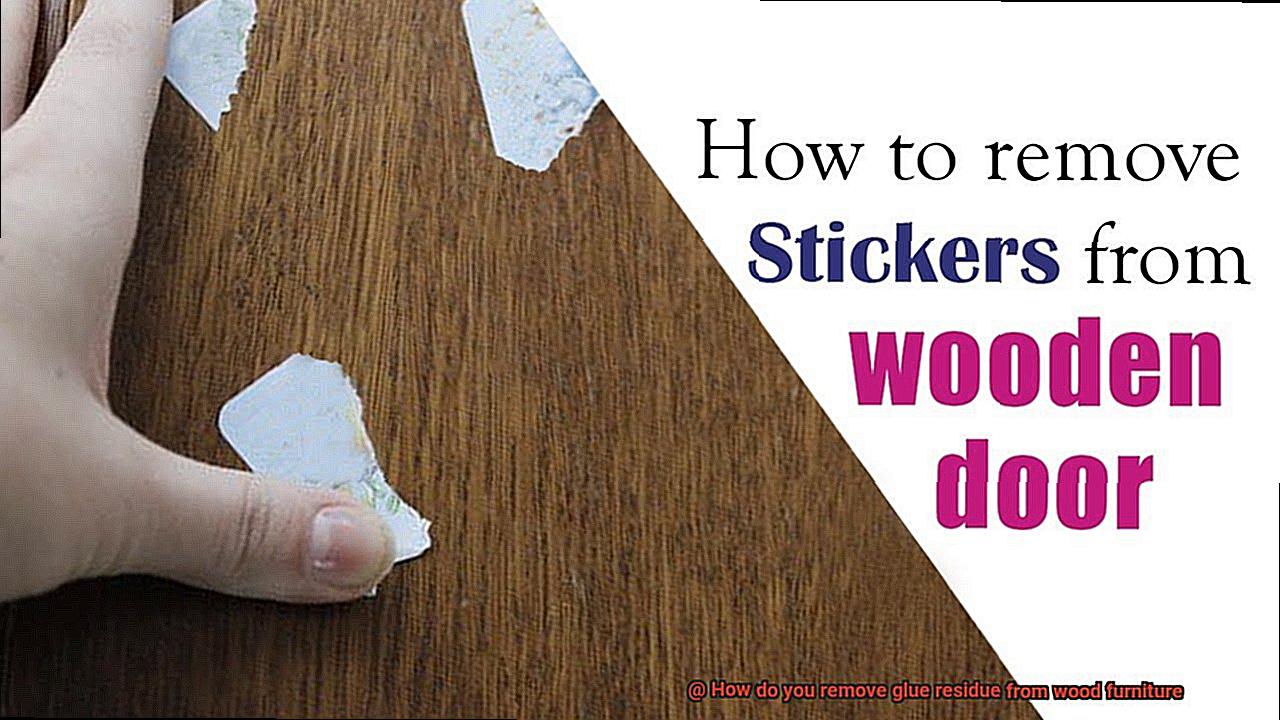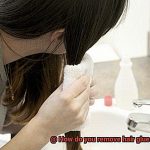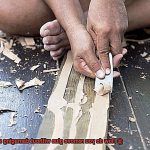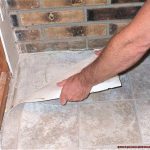Ever come across a stunning wooden furniture piece, only to be disappointed by the stubborn adhesive clinging to its surface? If you’re nodding along, don’t fret. We’ve got the ultimate solution to this annoying problem. Today, we’ll dive headfirst into the mysterious world of removing glue residue from wood furniture, uncovering secrets that will bring your beloved pieces back to their former glory.
Imagine this: You bring home a brand-new wooden dining table or inherit treasured antique drawers. But your excitement quickly fades when you notice sticky remnants left behind by pesky glues and adhesives. Fear not, for there is hope. From adhesive removers to natural remedies, we’re about to explore an array of solutions that’ll make your furniture shine once again.
In this enlightening guide, we’ll unravel the main culprits behind glue residue – whether it’s from labels, tape, or other adhesives. We’ll introduce you to an arsenal of methods, ranging from common household items to specialized adhesive removers guaranteed to eliminate that stubborn stickiness effectively. Plus, we’ll delve into techniques ensuring these methods won’t harm your cherished woodwork or leave it worse off.
From genius vinegar and baking soda concoctions to utilizing heat and solvents, our exploration covers tried-and-true techniques promising your wood furniture a new lease on life. Get ready for amazement as we venture into the depths of these solutions armed with insightful tips and step-by-step instructions tailored for each scenario.
So if you’re tired of concealing adhesive remnants or have resigned yourself to living with glue residue, this blog post is your saving grace. Join us on this remarkable journey as we unlock the secrets behind restoring your wood furniture’s shine and bid farewell to vexing glue residue remnants.
What is Glue Residue?
Contents
- 1 What is Glue Residue?
- 2 Causes of Glue Residue on Wood Furniture
- 3 Removing Glue Residue with Soapy Water
- 4 Removing Glue Residue with Rubbing Alcohol
- 5 Removing Glue Residue with Acetone or Nail Polish Remover
- 6 Using Adhesive Removers to Remove Glue Residues
- 7 Tips for Safely and Effectively Removing Glue from Wood Furniture
- 8 Conclusion
Glue residue is the pesky aftermath of working with wood and adhesive. Not only does it mar the beauty of your furniture, but it also leaves behind an uneven surface that attracts dust and dirt. Fear not. In this comprehensive guide, we will delve into the world of glue residue, exploring its forms and revealing effective techniques and solutions for removing it from wood furniture.
Understanding Glue Residue:
Glue residue is the stubborn adhesive material that clings to the surface of wood furniture long after the glue has dried. Its appearance varies depending on the type of glue used: sticky or tacky residues for solvent-based glues like epoxy or polyurethane, and dried, hard films for water-based glues such as white or yellow wood glue.
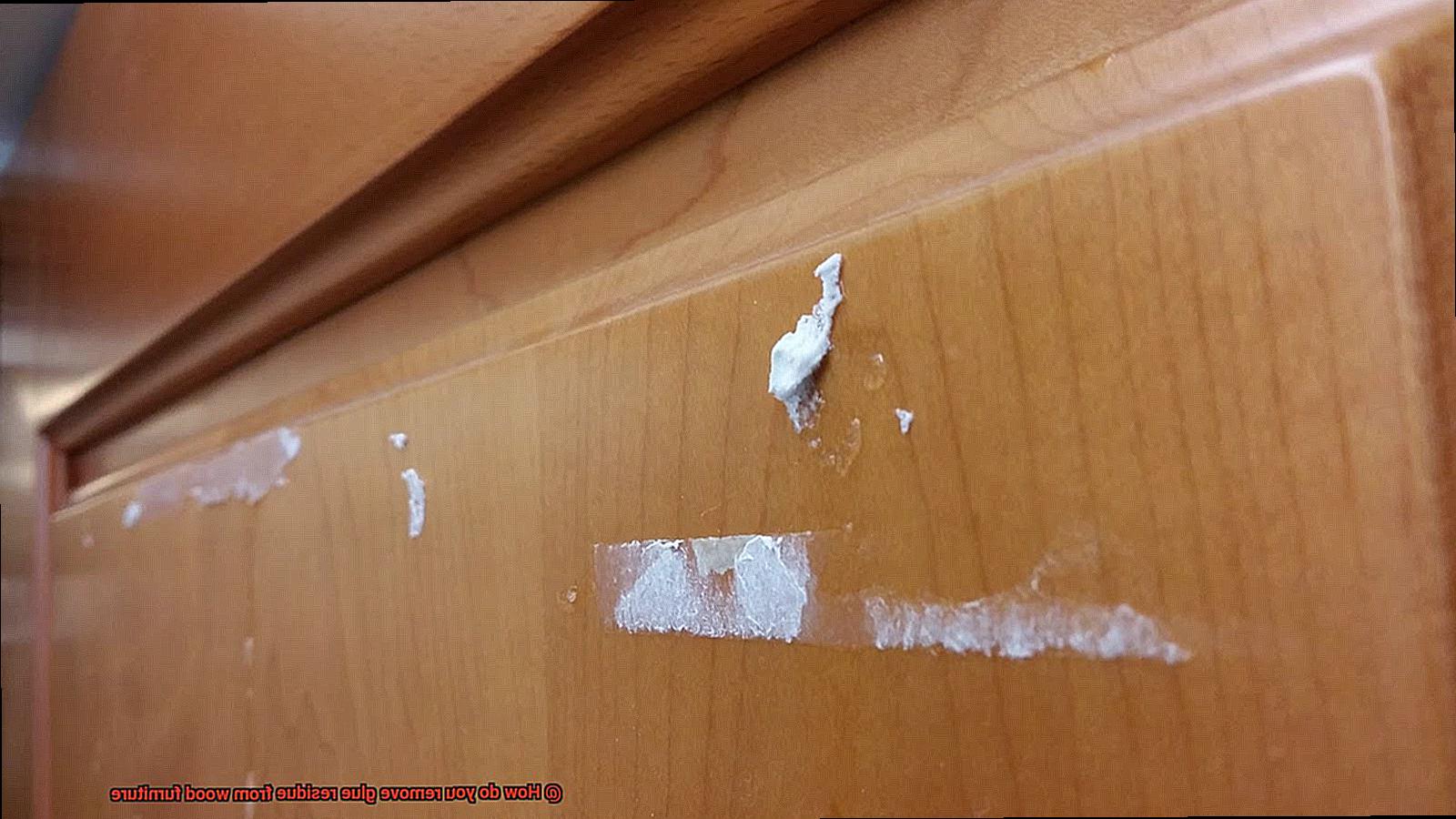
Methods for Glue Residue Removal:
Warm Water and Dish Soap:
- Immerse a cloth or sponge in warm, soapy water.
- Gently massage the glue residue in circular motions, applying delicate pressure.
- Watch as the glue residue surrenders its grip under your skilled touch.
Rubbing Alcohol:
- Dip a pristine cloth or sponge in a modest amount of rubbing alcohol.
- Gracefully dab it onto the glue residue, allowing it to work its magic for a few minutes.
- Employ a soft brush or cloth to tenderly scrub away the loosened adhesive until it vanishes into thin air.
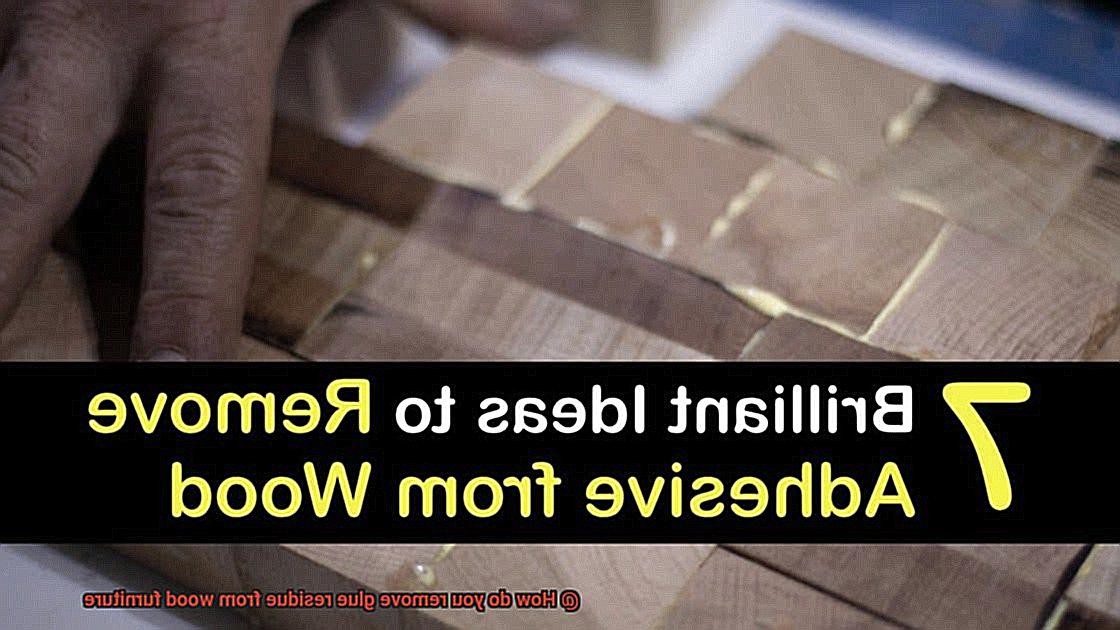
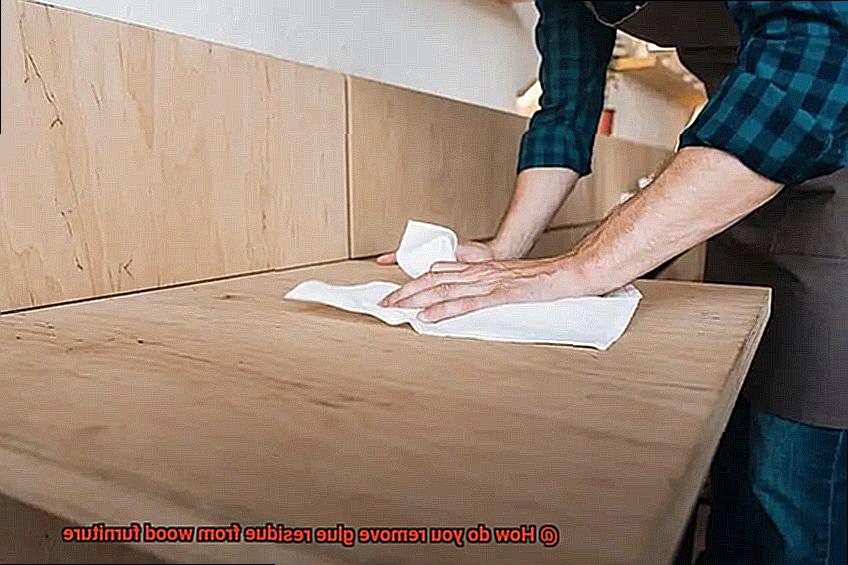
Acetone or Nail Polish Remover:
- Apply a small quantity of acetone onto a cloth or sponge.
- Dab it onto the glue residue, granting it time to dissolve the adhesive’s stronghold.
- With gentle elegance, whisk away the liberated glue using a soft cloth or brush.
Adhesive Removers:
- Opt for adhesive removers tailor-made for conquering glue residue.
- Consult the manufacturer’s instructions, applying the remover to a cloth or sponge.
- Gracefully rub it onto the glue residue, allowing it to work its enchantment for a few minutes.
- Wipe away the dissolved glue with a soft cloth or brush, reveling in your triumph.
Causes of Glue Residue on Wood Furniture
Glue residue on wood furniture can be a vexing problem that tarnishes the beauty of your beloved pieces. It’s like an unwelcome guest that refuses to leave, leaving behind a sticky mess. But fret not, my furniture aficionados.
In this comprehensive guide, we’re going to delve into the root causes of this pesky issue, equipping you with the knowledge to bid adieu to glue residue and restore your furniture’s impeccable allure.
Improper Application:
Imagine this scenario – you’re enthusiastically engaged in a DIY project or revamping a cherished heirloom. You eagerly wield your adhesive, only to find that it oozes out excessively from every nook and cranny.
Improper application is often the culprit here. Whether it’s using an excessive amount of glue or failing to spread it evenly, these missteps lead to stubborn residue that clings tenaciously. Take a moment to breathe and meticulously adhere to the manufacturer’s instructions regarding proper glue application. Your furniture will express its gratitude.
Subpar Adhesive Quality:
Dear friends, not all glues are created equal. Opting for a low-quality or bargain adhesive can spell disaster for your wood furniture. These inferior glues may fail to form a secure bond with the wood surface, resulting in feeble adhesion and, alas, copious glue residue. Spare yourself the agony by investing in a high-quality adhesive specially formulated for wood furniture. Trust me, it’s an investment worth making.
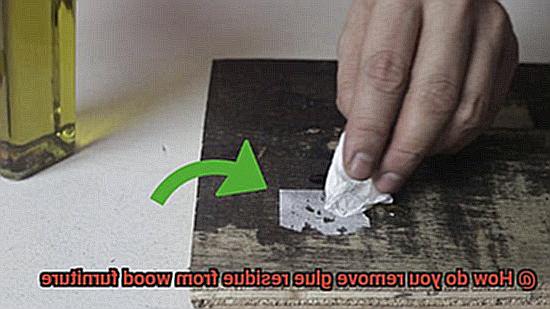
Insufficient Drying Time:
Patience truly is a virtue when it comes to allowing glue to dry properly. Hastening this crucial process often leads to incomplete bonding and residual glue that clings stubbornly like a memento from a forgettable date. So resist the temptation to rush into using or relocating your freshly glued masterpiece. Grant that adhesive the time it needs to dry and cure thoroughly before showcasing your craftsmanship.
Removing Glue Residue with Soapy Water
Glue residue on wood furniture can be a real pain, but fear not. I’m here to share with you a safe, easy, and effective method to bid adieu to this sticky mess. So grab a bucket, fill it with warm water, add a dash of mild dish soap, and let’s dive into the world of removing glue residue with soapy water.
Step 1: Gather Your Tools
First things first, make sure you have everything you need. You’ll need a bucket or basin filled with warm water and a gentle dish soap that won’t harm your furniture. Safety first, folks.
Step 2: Dampen and Wring
Now that you’re fully equipped, let’s get down to business. Take a clean cloth or sponge and dip it into the soapy water solution. Remember to wring out any excess water so you don’t drown your furniture in suds.
Step 3: Rub It in Circular Motions
With your damp cloth or sponge in hand, gently rub the glue residue in circular motions. Think of it as giving your furniture a soothing spa treatment. The warm soapy water will work its magic by loosening the adhesive bond and making it easier to remove.
Step 4: Don’t Be Afraid to Scrub (Gently.)
If the glue residue is being stubborn like an old mule, grab a soft-bristled brush or an old toothbrush and give it a gentle scrub. Remember, we’re aiming for thoroughness, not aggression. Applying too much pressure can damage the wood surface, and we definitely don’t want that.
Step 5: Rinse, Rinse, Rinse
Once the glue residue starts to lift off, it’s time for a little rinse. Grab some clean water and give the area a good rinse to remove any remaining soap residue. Just be careful not to go overboard and saturate the wood surface. A gentle sprinkle will do the trick.
Step 6: Dry It Out
After a refreshing rinse, it’s time to dry things off. Take a clean cloth and thoroughly dry the wood furniture. We want to remove any excess moisture to prevent damage or warping of the wood.
Removing Glue Residue with Rubbing Alcohol
Step 1: Test the Waters:
Before we dive headfirst into the realm of glue residue removal, let us exercise caution. Remember, each wooden surface possesses its own unique characteristics, and we must shield it from any undesired damage or discoloration. Begin by testing a small, unnoticeable area of your furniture with rubbing alcohol. Should it pass this test unscathed, we can proceed with confidence.
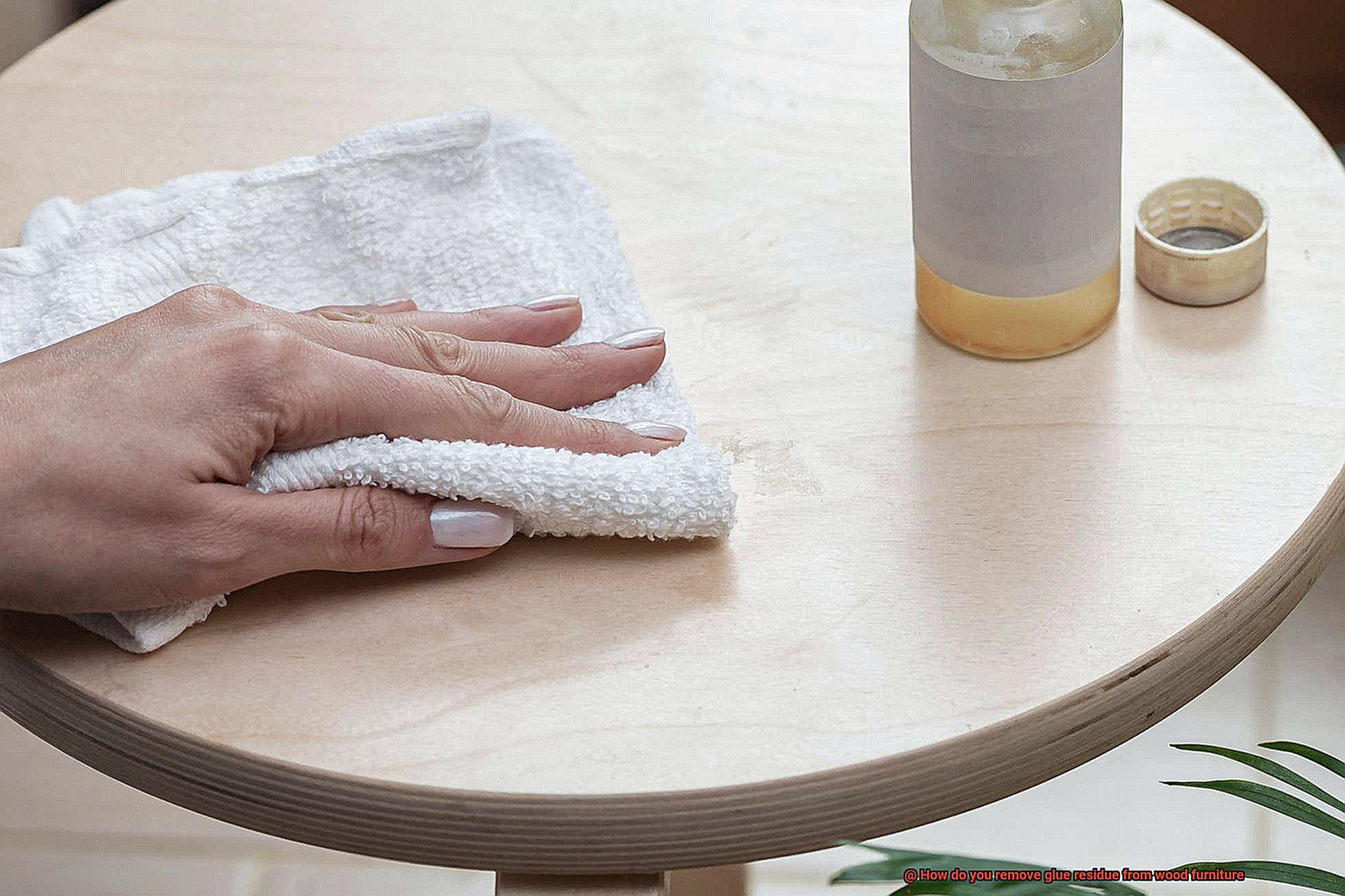
Step 2: Prep and Apply:
Having received the green light for rubbing alcohol treatment, it is time to roll up our sleeves and get to work. Equip yourself with a clean cloth or sponge and apply a modest amount of rubbing alcohol onto it. No need to drown it – just a touch will suffice.
Step 3: Circular Magic:
Now comes the thrilling part. Employ gentle circular motions to delicately rub the affected area. Apply a feather-light pressure as you let the rubbing alcohol weave its enchantment. Remember, our goal is to loosen that stubborn adhesive bond without causing harm to your treasured furniture.
Step 4: Persistence Pays Off:
If the glue residue puts up a valiant fight (as some often do), do not surrender just yet. Replenish your arsenal with more rubbing alcohol as necessary and press on, tirelessly rubbing until every last vestige of that sticky nuisance is but a distant memory. Remember, my friends, patience is the key to victory.
Step 5: Finishing Touches:
With the glue residue defeated, it is time to grant your furniture a triumphant finishing touch. Seize a clean, damp cloth and meticulously wipe down the area, eliminating any lingering traces of alcohol residue. And voila. Your wood furniture now stands liberated from the clutches of adhesive remnants.
Removing Glue Residue with Acetone or Nail Polish Remover
Fear not, for I am here to guide you through the magical world of acetone and nail polish remover – the ultimate weapons in your quest for a glue-free existence.
Let’s start with the basics. Acetone and nail polish remover are both excellent solvents for ridding wood furniture of pesky glue residue. Acetone, a powerful solvent, can dissolve various types of glues, including the remnants left behind by stickers or tape. Meanwhile, nail polish remover, with its main ingredient being acetone, is a formidable alternative in the battle against glue.
Now, before we dive into the excitement, a word of caution: always test the acetone or nail polish remover on a small, inconspicuous area of your furniture first. This critical step ensures that no damage or discoloration occurs during the removal process.
Assuming our test area approves of our chosen solvent, let’s get down to business. Grab a clean cloth or cotton ball and apply a small amount of acetone or nail polish remover to it. With gentle circular motions, unleash the power of the solvent upon the affected area. Patience is key here – it may take time and repeated applications to completely eliminate the glue residue and restore your furniture’s former glory.
But wait, our journey is not yet over. Once you’ve successfully banished all traces of glue, it’s time to give your furniture some well-deserved TLC. Cleanse the area with a mild soap and water solution, ensuring any remaining solvent residue is washed away. Now your furniture shines bright like a diamond – free from both glue and any lingering solvent.
However, dear adventurer, heed my warning – acetone and nail polish remover are flammable liquids. Always use them in a well-ventilated area away from open flames or sparks. And to protect your heroic fingers, it’s advisable to don a pair of gloves when handling these solvents.
Using Adhesive Removers to Remove Glue Residues
Embark on a heroic journey to rid your cherished wood furniture of stubborn glue residues. Armed with the mighty adhesive removers, we shall restore your furniture to its former glory. Join me as we unveil the secrets of these magical potions and conquer those pesky residues once and for all. Prepare yourself, for this is a quest not for the faint-hearted.
The Arsenal: Types of Adhesive Removers:
In our arsenal, we wield three formidable types of adhesive removers: the solvent-based warriors, the citrus-based saviors, and the eco-friendly naturals. Solvent-based removers, infused with potent chemicals like acetone and alcohol, fearlessly dissolve even the toughest adhesives. However, tread carefully and heed their instructions. For those seeking a safer alternative, the citrus-based heroes derived from luscious citrus fruits come to your rescue. Their gentle yet effective approach breaks down adhesive bonds without harming your precious wood surfaces. And if you champion the environment, look no further than the natural adhesive removers, armed with ingredients like vinegar and baking soda.
The Testing Ground: Ensuring Safety and Success:
Before plunging into battle, wisdom dictates that we test our chosen adhesive remover on a hidden spot of our furniture. This precaution ensures no unintended harm or discoloration befalls your beloved wooden companion. Remember, even heroes must exercise caution.
The Battle Plan: A Step-by-Step Guide:
Armed with our tested adhesive remover, let us unleash its power on the glue residue that dares to mar our furniture’s beauty. Take a clean cloth or sponge and apply a small amount of the remover onto it. Gently rub this enchanted cloth onto the affected area, allowing the remover to work its magic by breaking down those stubborn adhesive bonds.
Conquering the Residue: Triumph Over Tenacious Adhesives:
With unwavering patience and determination, take a soft cloth or sponge and wipe away the dissolved glue residue. For those resilient remnants, a touch of gentle scrubbing may be required. Remember, you are a warrior – victory is within reach.
Tips for Safely and Effectively Removing Glue from Wood Furniture
When it comes to removing glue from wood furniture, using the right method is crucial to avoid causing damage to the wood surface or leaving behind stubborn residue. In this article, we will explore expert tips for safely and effectively removing glue from wood furniture. By following these methods, you can ensure that your furniture stays beautiful and pristine.
Assess the Type of Glue:
Before diving into the removal process, it’s important to identify the type of glue on your wood furniture. Different glues require different removal methods. Water-based glues can often be easily softened and removed with warm, soapy water, while stronger adhesives like epoxy or super glue may need more specialized solvents or techniques. By determining the type of glue, you can choose the appropriate method for removal and minimize any potential damage.
Protect the Wood Surface:
As you begin the glue removal process, take precautions to protect the surrounding wood surface. Cover the area with plastic wrap or a drop cloth to prevent any accidental damage during the removal process. This simple step can save you from potential headaches and ensure that your furniture remains unscathed.
Gently Scrape Excess Glue:
Start by gently scraping off any excess glue using a plastic scraper or a credit card. Apply light pressure and use smooth strokes to avoid scratching or gouging the wood surface. By taking your time and being gentle, you can remove most of the excess glue without causing any harm.
Try Soapy Water or Mild Solvents:
For water-based glues, a simple solution of warm, soapy water can often do wonders in softening and removing the glue residue. Dampen a soft cloth with this solution and gently rub the affected area, being careful not to saturate the wood. If the glue proves to be more stubborn, you can also try using mild solvents such as rubbing alcohol or white vinegar. Apply these solvents to a cloth and gently rub the glue residue until it starts to loosen and dissolve.
Specialized Adhesive Removers:
In the case of stronger adhesives like epoxy or super glue, specialized adhesive removers can be your best bet. These products are specifically designed to break down the adhesive bond without causing harm to the wood surface. Follow the instructions provided by the manufacturer carefully and ensure proper ventilation when using these potent chemicals. With patience and precision, you can effectively remove even the toughest glue residues.
WgNIJ1ismRk” >
Conclusion
In conclusion, fear not the task of removing glue residue from your cherished wood furniture. With the right methods and tools at your disposal, you can restore these beloved pieces to their former glory. Warm water and dish soap, rubbing alcohol, acetone or nail polish remover, and specialized adhesive removers all offer solutions for every type of stubborn glue residue.
Throughout this process, keep a few key tips in mind. Test any method or product on a small, inconspicuous area before applying it to the entire surface. This precaution ensures that no damage or discoloration will mar your furniture’s beauty. Additionally, safeguard the wood surface by covering it with plastic wrap or a drop cloth during the removal process.
For water-based glues, gently scrape off excess glue and employ soapy water or mild solvents for effective results. When faced with stronger adhesives like epoxy or super glue, rely on specialized adhesive removers for optimal outcomes.
By adhering to these tried-and-true techniques, you can safely and effectively bid farewell to pesky glue residue without causing harm to your furniture’s exquisite surface.

